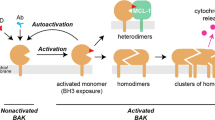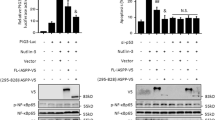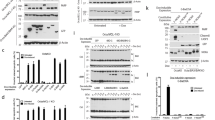Abstract
The prosurvival Bcl-2-family member Bfl-1/A1 is a transcriptional target of nuclear factor-κB (NF-κB) that is overexpressed in many human tumors and is a means by which NF-κB inhibits apoptosis, but its mode of action is controversial. To better understand how Bfl-1 functions, we investigated its interaction with proapoptotic multidomain proteins Bax and Bak, and the BH3-only proteins Bid and tBid. We demonstrate that in living cells Bfl-1 selectively interacts with Bak and tBid, but not with Bax or Bid. Bfl-1/Bak interaction is functional as Bfl-1 suppressed staurosporine (STS)-induced apoptosis in wild-type and Bax-deficient cells, but not in Bak−/− cells. We also show that Bfl-1 blocks tumor necrosis factor-α (TNFα)-induced activation of Bax indirectly, via association with tBid. C-terminal deletion decreased Bfl-1's interaction with Bak and tBid and reduced its ability to suppress Bak- and tBid-mediated cell death. These data indicate that Bfl-1 utilizes different mechanisms to suppress apoptosis depending on the stimulus. Bfl-1 associates with tBid to prevent activation of proapoptotic Bax and Bak, and it also interacts directly with Bak to antagonize Bak-mediated cell death, similar to Mcl-1. Thus, part of the protective function of NF-κB is to induce Mcl-1-like activity by upregulating Bfl-1.
This is a preview of subscription content, access via your institution
Access options
Subscribe to this journal
Receive 50 print issues and online access
$259.00 per year
only $5.18 per issue
Buy this article
- Purchase on Springer Link
- Instant access to full article PDF
Prices may be subject to local taxes which are calculated during checkout





Similar content being viewed by others
References
Breitschopf K, Zeiher AM, Dimmeler S . (2000). Ubiquitin-mediated degradation of the proapoptotic active form of bid. A functional consequence on apoptosis induction. J Biol Chem 275: 21648–21652.
Certo M, Del Gaizo Moore V, Nishino M, Wei G, Korsmeyer S, Armstrong SA et al. (2006). Mitochondria primed by death signals determine cellular addiction to anti-apoptotic BCL-2 family members. Cancer Cell 9: 351–365.
Chen L, Willis SN, Wei A, Smith BJ, Fletcher JI, Hinds MG et al. (2005). Differential targeting of prosurvival Bcl-2 proteins by their BH3-only ligands allows complementary apoptotic function. Mol Cell 17: 393–403.
Cheng EH, Wei M, Weiler S, Flavell RA, Mak TW, Lindsten T et al. (2001). BCL-2, BCL-XL sequester BH3 domain-only molecules preventing BAX- and BAK-mediated mitochondrial apoptosis. Mol Cell 8: 705–711.
Clohessy JG, Zhuang J, de Boer J, Gil-Gomez G, Brady HJ . (2006). Mcl-1 interacts with truncated Bid and inhibits its induction of cytochrome c release and its role in receptor-mediated apoptosis. J Biol Chem 281: 5750–5759.
Cory S, Huang DC, Adams JM . (2003). The Bcl-2 family: roles in cell survival and oncogenesis. Oncogene 22: 8590–8607.
Cuconati A, Degenhardt K, Sundararajan R, Anschel A, White E . (2002). Bak and Bax function to limit adenovirus replication through apoptosis induction. J Virol 76: 4547–4558.
Cuconati A, Mukherjee C, Perez D, White E . (2003). DNA damage response and MCL-1 destruction initiate apoptosis in adenovirus-infected cells. Genes Dev 17: 2922–2932.
Cuconati A, White E . (2002). Viral homologues of Bcl-2: role of apoptosis in the regulation of virus infection. Genes Dev 16: 2465–2478.
D’Sa-Eipper C, Chinnadurai G . (1998). Functional dissection of Bfl-1, a Bcl-2 homolog: anti-apoptosis, oncogene-cooperation and cell proliferation activities. Oncogene 16: 3105–3114.
Degenhardt K, Sundararajan R, Lindsten T, Thompson C, White E . (2002). Bax and Bak independently promote cytochrome C release from mitochondria. J Biol Chem 277: 14127–14134.
Desagher S, Osen-Sand A, Nichols A, Eskes R, Montessuit S, Lauper S et al. (1999). Bid-induced conformational change of Bax is responsible for mitochondrial cytochrome c release during apoptosis. J Cell Biol 144: 891–901.
Epand RF, Martinou JC, Fornallaz-Mulhauser M, Hughes DW, Epand RM . (2002). The apoptotic protein tBid promotes leakage by altering membrane curvature. J Biol Chem 277: 32632–32639.
Gélinas C, White E . (2005). BH3-only proteins in control: specificity regulates MCL-1 and BAK-mediated apoptosis. Genes Dev 19: 1263–1268.
Grinberg M, Sarig R, Zaltsman Y, Frumkin D, Grammatikakis N, Reuveny E et al. (2002). tBID homooligomerizes in the mitochondrial membrane to induce apoptosis. J Biol Chem 277: 12237–12245.
Grumont RJ, Rourke IJ, Gerondakis S . (1999). Rel-dependent induction of A1 transcription is required to protect B cells from antigen receptor ligation-induced apoptosis. Genes Dev 13: 400–411.
Herold MJ, Zeitz J, Pelzer C, Kraus C, Peters A, Wohlleben G et al. (2006). The stability and anti-apoptotic function of A1 are controlled by its C terminus. J Biol Chem 281: 13663–13671.
Holmgreen SP, Huang DC, Adams JM, Cory S . (1999). Survival activity of Bcl-2 homologs Bcl-w and A1 only partially correlates with their ability to bind proapoptotic family members. Cell Death Differ 6: 525–532.
Hsu YT, Youle RJ . (1998). Bax in murine thymus is a soluble monomeric protein that displays differential detergent-induced conformations. J Biol Chem 273: 10777–10783.
Karsan A, Yee E, Harlan JM . (1996). Endothelial cell death induced by tumor necrosis factor-alpha is inhibited by the Bcl-2 family member, A1. J Biol Chem 271: 27201–27204.
Konopleva M, Contractor R, Tsao T, Samudio I, Ruvolo PP, Kitada S et al. (2006). Mechanisms of apoptosis sensitivity and resistance to the BH3 mimetic ABT-737 in acute myeloid leukemia. Cancer Cell 10: 375–388.
Kucharczak JF, Simmons MJ, Duckett CS, Gelinas C . (2005). Constitutive proteasome-mediated turnover of Bfl-1/A1 and its processing in response to TNF receptor activation in FL5.2 pro-B cells convert it into a prodeath factor. Cell Death Differ 12: 1225–1239.
Kuwana T, Bouchier-Hayes L, Chipuk JE, Bonzon C, Sullivan BA, Green DR et al. (2005). BH3 domains either sensitize or activate mitochondrial apoptosis, serving as prototype cancer therapeutics. Mol Cell 17: 525–535.
Lee HH, Dadgostar H, Cheng Q, Shu J, Cheng G . (1999). NF-kappaB-mediated upregulation of Bcl-x and Bfl-1/A1 is required for CD40 survival signaling in B lymphocytes. Proc Natl Acad Sci USA 96: 9136–9141.
Letai A . (2006). Restoring cancer's death sentence. Cancer Cell 10: 343–345.
Letai A, Bassik MC, Walensky LD, Sorcinelli MD, Weiler S, Korsmeyer SJ . (2002). Distinct BH3 domains either sensitize or activate mitochondrial apoptosis, serving as prototype cancer therapeutics. Cancer Cell 2: 183–192.
Michels J, Johnson PW, Packham G . (2005). Mcl-1. Int J Biochem Cell Biol 37: 267–271.
Nguyen M, Millar DG, Yong VW, Korsmeyer SJ, Shore GC . (1993). Targeting of Bcl-2 to the mitochondrial outer membrane by a COOH-terminal signal anchor sequence. J Biol Chem 268: 25265–25268.
Oltvai ZN, Milliman CL, Korsmeyer SJ . (1993). Bcl-2 heterodimerizes in vivo with a conserved homolog, Bax, that accelerates programmed cell death. Cell 74: 609–619.
Perez D, White E . (2000). TNF-alpha signals apoptosis through a bid-dependent conformational change in Bax that is inhibited by E1B 19K. Mol Cell 6: 53–63.
Sedlak TW, Oltvai ZN, Yang E, Wang K, Boise LH, Thompson CB et al. (1995). Multiple Bcl-2 family members demonstrate selective dimerization with Bax. Proc Natl Acad Sci USA 92: 7834–7838.
Somogyi RD, Wu Y, Orlofsky A, Prystowsky MB . (2001). Transient expression of the Bcl-2 family member, A1-a, results in nuclear localization and resistance to staurosporine-induced apoptosis. Cell Death Differ 8: 785–793.
van Delft MF, Wei AH, Mason KD, Vandenberg CJ, Chen L, Czabotar PE et al. (2006). The BH3 mimetic ABT-737 targets selective Bcl-2 proteins and efficiently induces apoptosis via Bak/Bax if Mcl-1 is neutralized. Cancer Cell 10: 389–399.
Wang CY, Guttridge DC, Mayo MW, Baldwin Jr AS . (1999). NF-kappaB induces expression of the Bcl-2 homologue A1/Bfl-1 to preferentially suppress chemotherapy-induced apoptosis. Mol Cell Biol 19: 5923–5929.
Wei MC, Lindsten T, Mootha VK, Weiler S, Gross A, Ashiya M et al. (2000). tBID, a membrane-targeted death ligand, oligomerizes BAK to release cytochrome c. Genes Dev 14: 2060–2071.
Wei MC, Zong WX, Cheng EH, Lindsten T, Panoutsakopoulou V, Ross AJ et al. (2001). Proapoptotic BAX and BAK: a requisite gateway to mitochondrial dysfunction and death. Science 292: 727–730.
Werner AB, de Vries E, Tait SWG, Bontjer I, Borst J . (2002). Bcl-2 family member Bfl-1/A1 sequesters truncated Bid to inhibit its collaboration with proapoptotic Bak or Bax. J Biol Chem 277: 22781–22788.
Willis SN, Chen L, Dewson G, Wei A, Naik E, Fletcher JI et al. (2005). Proapoptotic Bak is sequestered by Mcl-1 and Bcl-xL, but not Bcl-2, until displaced by BH3-only proteins. Genes Dev 19: 1294–1305.
Yi X, Yin XM, Dong Z . (2003). Inhibition of Bid-induced apoptosis by Bcl-2. tBid insertion, Bax translocation, and Bax/Bak oligomerization suppressed. J Biol Chem 278: 16992–16999.
Zhang H, Cowan-Jacob SW, Simonen M, Greenhalf W, Heim J, Meyhack B . (2000). Structural basis of Bfl-1 for its interaction with Bax and anti-apoptotic action in mammalian and yeast cells. J Biol Chem 275: 11092–11099.
Zong WX, Edelstein LC, Chen C, Bash J, Gélinas C . (1999). The prosurvival Bcl-2 homolog Bfl-1/A1 is a direct transcriptional target of NF-κB that blocks TNFα-induced apoptosis. Genes Dev 13: 382–387.
Acknowledgements
We thank R Sundararajan, D Perez and N Gupta for discussions. This work was supported by NIH Grant CA083937, the Charlotte Geyer Foundation and the Foundation of UMDNJ. MJS was partially supported by NIH predoctoral training Grant GM08360.
Author information
Authors and Affiliations
Corresponding author
Additional information
Supplementary Information accompanies the paper on the Oncogene website (http://www.nature.com/onc).
Supplementary information
Rights and permissions
About this article
Cite this article
Simmons, M., Fan, G., Zong, WX. et al. Bfl-1/A1 functions, similar to Mcl-1, as a selective tBid and Bak antagonist. Oncogene 27, 1421–1428 (2008). https://doi.org/10.1038/sj.onc.1210771
Received:
Revised:
Accepted:
Published:
Issue Date:
DOI: https://doi.org/10.1038/sj.onc.1210771
Keywords
This article is cited by
-
Mechanisms of BCL-2 family proteins in mitochondrial apoptosis
Nature Reviews Molecular Cell Biology (2023)
-
Targeting multifunctional magnetic nanowires for drug delivery in cancer cell death: an emerging paradigm
Environmental Science and Pollution Research (2023)
-
NF-κB activity during pancreas development regulates adult β-cell mass by modulating neonatal β-cell proliferation and apoptosis
Cell Death Discovery (2021)
-
Angiotensin II type 2 receptor promotes apoptosis and inhibits angiogenesis in bladder cancer
Journal of Experimental & Clinical Cancer Research (2017)
-
BCL2A1: the underdog in the BCL2 family
Cell Death & Differentiation (2012)



